Ordinarily any trip I make to Chelsea wherein I go from gallery to gallery I'd call a gallery slog. But today's entry is different. It wasn't a slog, it was a merely dispirited ramble. I had no real direction, and was only wandering around seeing what was open and wandering in. With no list of galleries, with no required stops, I could quit whenever I felt like it. I felt like it fairly quickly, but now that I look back on it, I saw a good number of shows. Not too many of them were good, however.
To start off on a good note, I'm going to put aside the site's guidelines (vague and incoherent as they may be) and review a show by a known, dead artist. This makes my opinion even less useful than usual. Thanks to Art Ravels I ended up at one of Larry Gagosian's endlessly metastasizing gallery spaces enjoying Pablo Picasso's Mosqueteros (ending June 6, 2009).

Pablo Picasso, Femme Nue avec Tète d'Homme, 1967, oil on canvas, 51x38 inches
Mosqueteros is, of course, Spanish for "Mouseketeers", so obviously this is a show entirely devoted to, as you can see, nude portraits of Picasso's favorite model and mistress, Annette Funicello.
No, of course that's not it. It's a show of Musketeers, another class of Picasso's personal cast of characters, along with the Minotaur, Harlequin, Toreadors, Marie-Thérèse, African masks, the Horny Painter, Overweight Models with Big Boobs, and Michael Jackson.
You can tell I'm kind of making fun of Pablo here, and why not? He often seemed to be having so much fun painting he fell headlong into self-caricature; unless the trouble is he got lazy and figured he could sell pretty much any mark he made on any surface. (One of the paintings in this show is on corrugated cardboard, certainly long past the point where he could afford real art supplies.) He was so prolific it's hard to figure what he was doing, let alone what he thought he was doing. I have immense affection for Picasso, though, hard won past my layers of cynicism and jaundice towards self-promotion and his probably not entirely deserved reputation. Honestly his actual work doesn't do a lot for me, but each time I find myself in front of his paintings I find more to appreciate. Something about his brushwork, which seems at times so easy and others so labored; I can feel his hand in each one, and while maybe the overall picture might rarely be great, still I love that hand. It also helps, I think, to have read Patrick O'Brian's fantastic biography of the man, and thanks to the wonder of the Internet you can now follow along and see every work he describes at the On-Line Picasso Project.
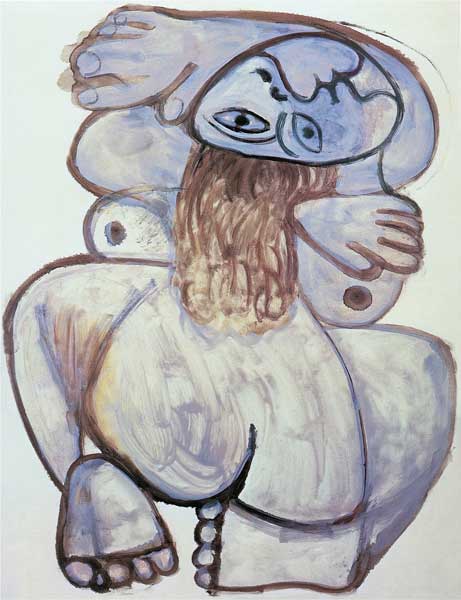
Pablo Picasso, Nu accroupi II, 1971, oil on canvas, 116x89 cm
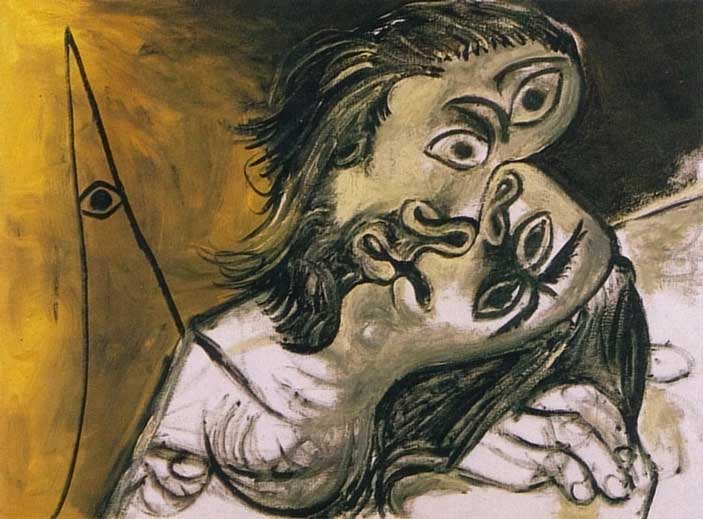
Pablo Picasso, Le baiser I, 1969, oil on canvas, 97x130 cm
Here in Gagosian's show I found, as I expected, very few really good paintings. But I was surprised to see a couple I liked very much. Picasso's work certainly has great energy, and in a few of these works there's enough, I think, to achieve lift over his patches of overwrought sticky paint and his swathes of underexposed watery washes. Look at the latter two paintings I've put up here: A lovely quick study of a nude's back; a passionate Cubist rendering of a loving kiss. Both are noticeably imperfect but wonderful just the same.
Altogether there's a lot to see in Mosqueteros and it's worth the trip, even if Picasso -- late period especially -- isn't your favorite. He may still surprise you.
Still, as much as I liked the show, the question in my mind is, why show Picasso? Are there really no contemporary artists who could fill Gagosian's space? I can't understand it. A few years back, Ed Winkleman suggested I read The Art Dealers to get an idea of how the minds of art dealers actually work. I read the book. I gained precisely zero insight. I never understand what dealers are thinking, and in this case I understand even less. Why show Picasso in a selling gallery?
To raise Picasso's stature? As if the likes of Larry Gagosian could do that. Picasso's one of the few artists of any kind who could be named by non-art people. To raise Larry Gagosian's stature? As if late-career Picasso could do that. Most everyone in the art world knows, before any painting in this show was even a gleam in Picasso's eye, Marcel had put Pablo's shit out in the street. By the mid-1960s Picasso was, according to art-world wisdom, a has-been, noodling out his remaining days. Even if Duchamp's victory wasn't unanimous, still among artists for whom Modernist is not an insult, late period Picasso is dismissed as junk. Is Larry angling for a critical reappraisal of Pablo's declining years? Jerry Saltz liked the show. But why should Larry care what Jerry thinks about Pablo?
And who else is likely to be impressed by this show? Plenty of regular people seemed to be in attendance -- the name "Picasso" is like a magic pipe, drawing hoi polloi from all around -- but I can't imagine Gagosian cares about them. They don't buy million-dollar paintings. I guess the collectors whose pieces are on loan for the show might get a rosy glow. Is that going to translate into more sales for Larry? Of what? Who's going to buy Richard Prince's crap after seeing a show of actual, real live original paintings made of paint by a painter? As bad as Picasso's later paintings might seem -- not that I think they're bad -- compared to, say, Yayoi Kusama, they look like, well, a million bucks.

Yayoi Kusama, Enlightenment Means Living a Life Unconcernedly, 2008, acrylic on canvas, 76 3/8x102 inches
Speaking of Yayoi, I saw her show also, at another one of Gagosian's many spaces (at 555 West 24th until June 27, 2009). I found it exuberant but mediocre. Her paintings are wonderfully colored extravaganzas, often to the point of optical pain. Only one or two of them evinced any subtlety whatsoever (for example, the one shown here); the rest were like brightly-colored grade school tempera paintings. With a bad case of the spots. I almost feel bad not enjoying Yayoi's work more, because it's so cheerful and sincere and happy. I feel like a curmudgeon. But it just didn't move me; and the juxtapositions of color -- black and orange! red and green! -- often struck me as more childish than childlike. When she allows for variations of shading her all-over paintings are neat (although not nearly as sublime as they appear in JPEGs) but more often she fills up the canvas without varying much and it just tires the eye.
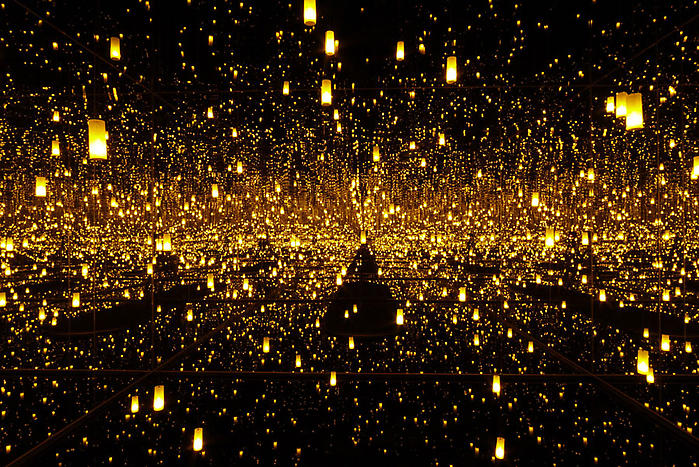
Yayoi Kusama, Aftermath of Obliteration of Eternity, 2009, mixed media installation, 163.5x163.5x113.25 inches
One commendable, although not to my mind entirely successful, piece in the show is Yayoi's Aftermath of Obliteration of Eternity. The title makes it sound like an overblown Damien Hirst thing, but in fact it's a simple and elegant idea -- albeit not, perhaps, easy to build. It's a room, maybe ten or fifteen feet on a side, lined inside with mirrors, lit by a multitude of small dim yellowish candle-like LEDs hanging from wires at different heights throughout the space. With a pool on the floor and the door closed behind you -- Gagosian had a helpful guard handling door duty for guests -- it almost, but not quite, makes you feel as if you're hanging in an infinite space surrounded by candles. I say almost because the mirrors aren't distortion-free, and as the reflections multiply they lose coherence; and also you can see your own silhouette, of course, which kind of breaks the spell. And further the pool of water ripples unless you stand very, very still. Overall it seemed to me the idea could've been executed a little better -- I'm sure they make higher-quality mirrors with less distortion, and maybe the floor should be mirrors, too -- but then maybe I'm nitpicking. I don't know. I wasn't as moved by it as I wanted to be, but I had to admit it was kind of cool. Maybe as an isolation tank it'd be mind-blowing: I can see floating on my back in a pool of epsom salted water meditating on the universe in the middle of an infinitude of lights. Then again, this is the kind of thing I expect from children's museums, not art galleries.
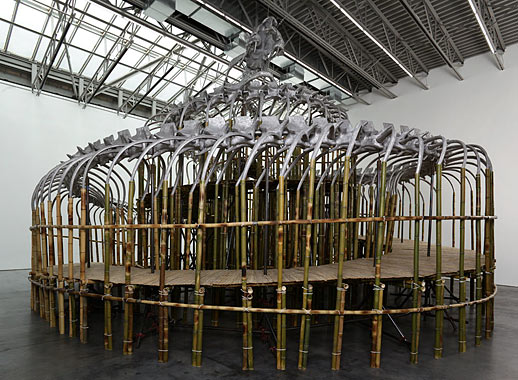
Huang Yong Ping, Tower Snake, 2009, aluminum, bamboo, steel, 22x39x37 feet
Yet there are days when Chelsea seems to have turned into a children's museum. Why the contemporary art world would aim so low is beyond me, but again, I gained zero insight from The Art Dealers. Maybe I'm just dense. Which may be why I was so nonplussed by the sight of Huang Yong Ping's Tower Snake at Gladstone Gallery (until June 13, 2009). Like the Giant Heart at the Franklin Institute in Philadelphia, the Tower Snake is a hugely enlarged version of an organ you can walk through. Only the organ in this case is the skeleton of a snake, and the purpose isn't educational, it's dada. Or something. There may very well be something completely fantastic and wonderful at the top under the skull, but I wouldn't know, because the altogether amateur-hour-looking structure (some of it is held together with worm gear hose clamps) didn't look sturdy enough to support 315 pounds of heaving gweilo. Since the very first thing you see upon entering the gallery is a large sign warning you about your own risk, I stayed safely on the ground. I love me some bamboo and all, but I don't want to stand on it.
Meanwhile over at Mary Boone the scientific exploration continues, this exhibit (until May 16, 2009) being organized around microcephaly. Curator Javier Peres has dropped a few tiny, pointless objects by tiny, pointless artists Mike Kelley, Terence Koh, and Jeff Koons into the cavernous airplane hangar that is the Mary Boone Gallery. The space makes the worthless little things look even more crappy and stupid than they might otherwise: Mike's lumpy collections of what look like handmade buttplugs, lit from underneath; Terence's long white shelf, so minimalist it makes Ikea furniture look baroque; and Jeff Koons' oh-so-amusing steel replica of a set of crystal glasses (get it? Get it?). Javier happily gushes in the press release: "My purpose in assembling this exhibition was not to emphasize a curatorial message as such, but rather -- quite simply -- to put three of my favorite American artists side by side. No tricks, no gimmicks, no bullshit, just sculptures representative of each artist's practice." We appreciate your honesty and simplicity, Javier, we just wish your favorite artists didn't suck so hard.
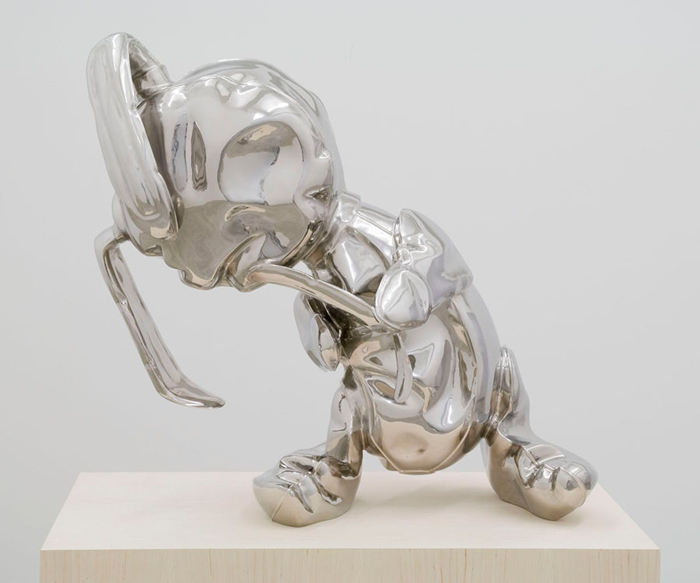
Jonathan Monk, Deflated Sculpture no. II (still standing), 2009
Did someone mention Jeff Koons? I ask because I got to peek in the front window of Casey Kaplan to see one of the signature pieces of Jonathan Monk's show, The Inflated Deflated (until June 20, 2009). Yes, that sculpture is, in fact, as stupid as it appears to be. Compounding the stupidity -- maybe this is a scientific exhibit on the gullibility of art dealers -- Jonathan writes in the show's press release, "Appropriation is something I have used or worked with in my art since starting art school in 1987. At this time (and still now) I realised that being original was almost impossible, so I tried using what was already available as source material for my own work. By doing this I think I also created something original and certainly something very different to what I was re-presenting. I always think that art is about ideas, and surely the idea of an original and a copy of an original are two very different things." Which is a pretty fantastic piece of sophistry -- in fact it's an insult to Sophists to call it such. Here Jonathan's saying being original is really hard, so he's done nothing for his entire art career but copy other artists, but his copies are actually original because they're not intended as originals. And then he goes and copies non-artist Jeff Koons! I don't know if Jonathan's next show should be titled "Big Brass Balls" or "Sadly Empty Head". Possibly both.
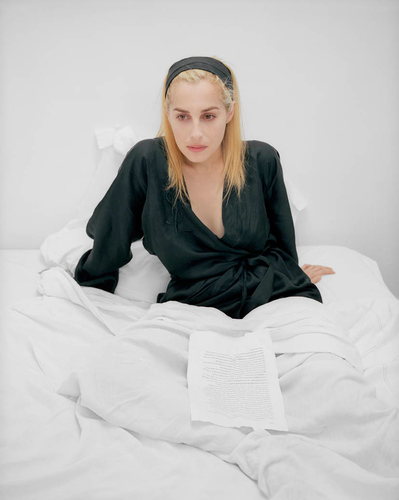
Sophie Calle, Take Care of Yourself (Amira Casar, Actress), 2007
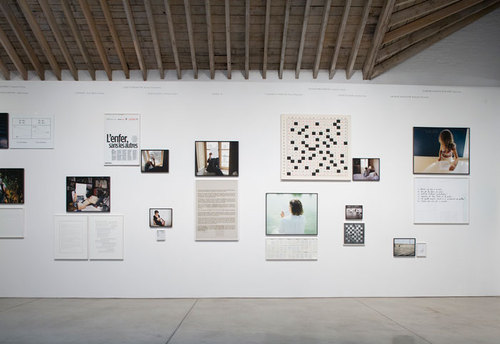
Sophie Calle, Take Care of Yourself (installation view, photo by Seth Erickson), 2007
On the other hand, Jonathan's work does have the virtue of being comprehensible. Dumb, but understandable nonetheless. In this way it is thoroughly unlike Sophie Calle's Take Care of Yourself at Paula Cooper (until June 6, 2009). The gallery's entire wall space is crammed almost full of photos, drawings, wall text, videos, and who knows what all else, which the artist herself says is "executed in a wild range of media". Well, there's wild and then there's overstuffed. Maybe the whole show makes some kind of sense if you're feeling exceptionally patient with the artist -- if you sense, somehow, that she has something really important to say. Sophie says it's something to do with reactions to a break-up letter she got over e-mail, and I imagine it's possible another viewer might find this a fascinating, deeply moving topic, and might have that fascination and emotion hinted at by something in the show; and then that viewer might settle in for the long work of decoding what's going on with the Indian dancer glancing at the typing paper and the actress sort of staring moodily off into the middle distance and the crossword puzzle. Yes, the crossword puzzle. Unfortunately I'm not that viewer; I'm the viewer who glanced around, thought "What the fuck?" and left. Give me something of visual interest, some crumb of anything that makes this actual art and not a masturbatory MySpace page with its own YouTube channel, and maybe I'll stick around. But no.
I get the feeling that Sophie is that sort of quintessential artist type who is so sensitive and so hopelessly untethered from anything approaching reality that when her jerk boyfriend dumps her over e-mail she can honestly respond, "I received an email telling me it was over. I didn't know how to respond. It was almost as if it hadn't been meant for me." So she sets about putting together a completely bizarre and aimless exercise based on the sliver of human experience she can understand and fills up a blameless room with the results and calls it "art" because no one knows what else to call it. And she's such a flake anyhow she must be some kind of genius.
Those kinds of artists irritate the hell out of me.
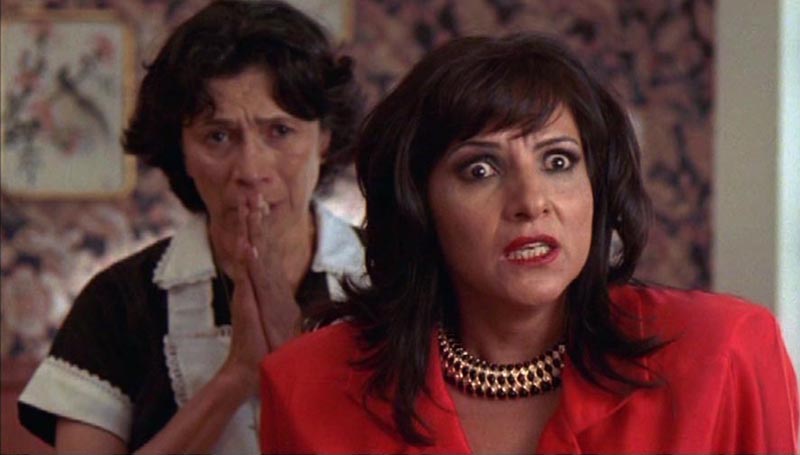
Phil Collins, soy mi madre, 2008, 16mm film transferred to digital video, duration 28 minutes
Anyway. Now that we've edged away from the children's science museum and into the Web and TV, we can find ourselves at Tanya Bonadkar checking out Phil Collins' when slaves love each other, its not love [sic] (until June 20, 2009). A handful of desultory photos lead you towards that boomy audio sound which heralds yet another entry of lame video art and you duck through the curtain into the ubiquitous video room which, in this case, appears to be showing a telenovela. If you're like me you rapidly figure out that Phil -- no relation, I trust, to the drummer from Genesis and composer of Disney's Tarzan -- has no grasp of the fundamental ingredient of all telenovelas and, in fact, all Latino TV -- cleavage -- and you rapidly leave the way you came.
Curiously, however, there are still galleries showing traditional art being made by living artists. Not everyone has gotten the news about the children's museum thing, I guess. My eye was caught as I walked by Charles Cowles, for example, where I saw Jeff Bark's Flesh Rainbow (until May 23, 2009). If that sounds as if it's the title of a lurid show of large-scale photos, well, it is. It's that wonderfully safe, contemporary artsy kind of lurid, where everything's all grotesque and abject, full of shame and damp, squalid sordidness; the key is making the subjects so gnarly and grotty, or else so humorous, that they can be safely kept at arm's length by the beautiful art worlders who are looking down on them.
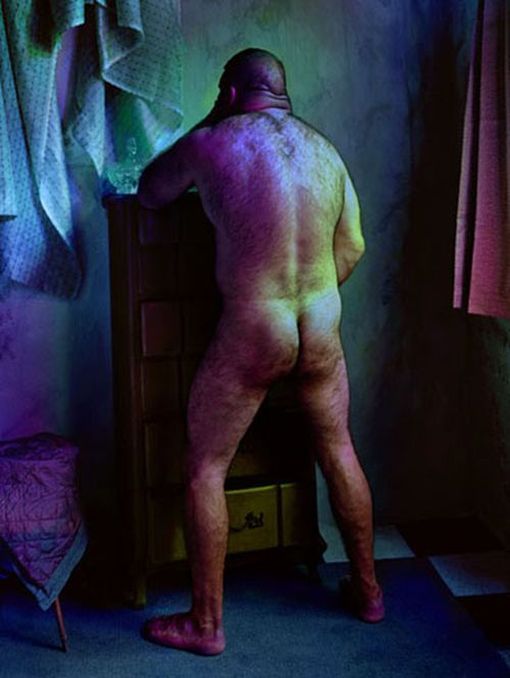
Jeff Bark, It's Easy to Forget, 2009, c-print, edition of 9
This one I've put up here looks like Jeff caught me jerking off into my wife's sock drawer. Really, I get the impression that what Jeff honestly likes is seeing pretty girls naked, but he needs an excuse; he needs to be taken seriously as an artist so he can get the best naked girls. So he also takes stagey photos of wilted potted plants and hairy guys in pantyhose, so it doesn't look like he's all about the chicks.
Then again, maybe I'm just projecting.
Anyway, his photos are big and his choice of colors interesting. Naked people are always fun. And some of his compositions, and the way he photographs them, harken back to the early days of photography, and those infamous French postcards, and Bellocq's Storyville photos of slightly overfed, slightly overloose women. Not altogether a bad thing, but then again, not altogether great, either.
Maybe photography's not traditional enough for you. Too new. If so, I'm with you. That's okay, there's still some old-fashioned art being made by real live non-deceased artists. You might stop, as I did, in Danese Gallery, hoping for some. And you'd get it. Until May 29, 2009, you can get a whole lot of it. The current show there (until May 29, 2009) consists of what seemed to me to be about a hundred works of art, ranging from Minimalist cubes on plinths through clunky bronzes on the floor up to black ink on white paper on the wall. Some of the artists are gone -- David Smith, Roberto Matta -- some are still working -- Richard Serra, Mark di Suvero -- at least one is even reasonably young.

Craig Kauffman, Mansanas, 2007, acrylic lacquer on vacuum formed Plexiglas, 33.5x39.25x12 inches
Amusingly enough, very little in the show really struck me as interesting, except for the least traditional piece there. David Smith's doodles kind of spoke to me, because his stroke reminded me of my own while at the same time seeming very different. Larry Bell's Cube #36 (green and blue) had a smoky allure to it. Elizabeth King's untitled bronze head was definitely skilfully sculpted. But the piece I found most delightful was Craig Kauffman's vacuum-formed plastic sculpture. It's so pink and sparkly and inviting, like a giant space breast waiting for someone to pillow their head upon, or maybe like a happy pseudopod of some pleasant alien. It's smooth and shiny and it turns out "mansanas" is Tagalog for "apple". It has its own reasons for being, and I like that.
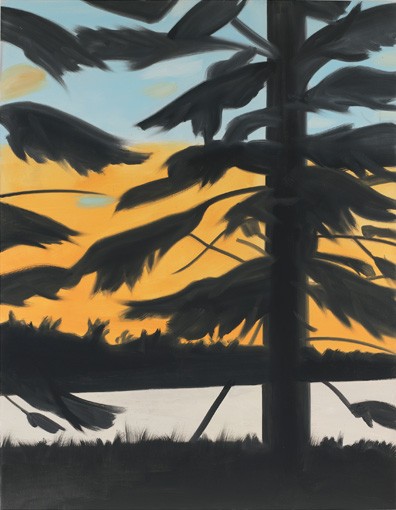

Alex Katz, Sunset 1, 2008, oil on linen, 9x7 feet and Sunset 2, same thing
Maybe we need to be more traditional still. We might drop in PaceWildenstein to see Alex Katz's latest paintings in the show titled Fifteen Minutes (until June 13, 2009). Alex is pretty traditional, right? I mean, he single-handedly revived figurative painting in the 1970s. Or something. Personally I'd say that Alex is the grandfather of Feeble Painting the way Manet is the grandfather of Impressionism. Impressionism is good. Feeble Painting not so much. With these works, at least, Katz is clearly trying to do for landscapes what he did for figuration: Dumb it down and flatten it out.
And, yes, he succeeds at squashing landscape painting as effectively he did figuration. The result is unsuccessful as art, but what would you expect? Despite the fact that the paintings are all of heroic proportions -- the dimensions are listed in feet, not inches, and tend to the 8-foot range -- Alex has only managed to scale up his infelicitous touch and uninspired paint handling. His sense of color is virtually absent, which is especially sad here, since these paintings are grouped by subject, where he apparently painted the same landscape at different times of day. This leads me to imagine he was intending these to be studies of color and light, but since Alex appears to have the tonal range of a cheap Instamatic camera, they look more like slight variations for different floors in the same hotel. He's using oil paints but for all the painterly blending he's ever been able to manage he might as well be using latex housepaint. About the best thing one can say about Katz is that he hasn't lost his skills with age; he just never had any to begin with.
Well, no slog or ramble through Chelsea would be complete without a walk through good old 511 West 25th Street. First stop: The bathroom, of course. Best bathrooms in Chelsea. Flush like a jet engine, Kramer! Right. Anyway. But after that, yes, of course I stopped by McKenzine Fine Art to interrupt Valerie McKenzie's lunch and incidentally find Don Voisine's show (until June 6, 2009).

Don Voisine, Buzz, 2009, oil on wood, 17x17 inches
Don Voisine's a taper, with a smooth, rigid geometric style and, from what I've seen so far, a basic approach. It looks as if he's very carefully stepping through small variations -- change one color here, change one angle there -- and repeating, repeating, repeating. The result is, all together in this one show, somewhat, well, repetitive, but nevertheless effective. His subtleties and slight changes encourage slowing down and tuning in to finer distinctions; your reward is feeling the changes he's made between differing textures of black, the shift from a muted green to a muted pink, the shades of gray. It's a narrow, constrained universe, but an expressive one; and it's rewarding enough to make it worth going around the show more than once.
"You've gone around a couple of times," Valerie said to me finally, "so you either love it or you hate it."
I don't go around a show more than once if I hate it. I'm willing to stick my head in the door and turn right around without even going in if it's that bad. No sense wasting time on something awful. No: If I go around more than once it's because there's something I'm willing to consider. And Don's work has that.
It also has something else going for it, which I noticed when I looked over the price list: Affordability. Don's work is priced very reasonably. So reasonably, in fact, that I'd almost buy one myself. It's still far more than I can afford, though, since this blog doesn't pay very well. (Or at all.) I did, however, consider telling the only person I know who actually buys art about Don's work -- and then I remembered J.T. Kirkland already bought one. He's got a good eye, that one.
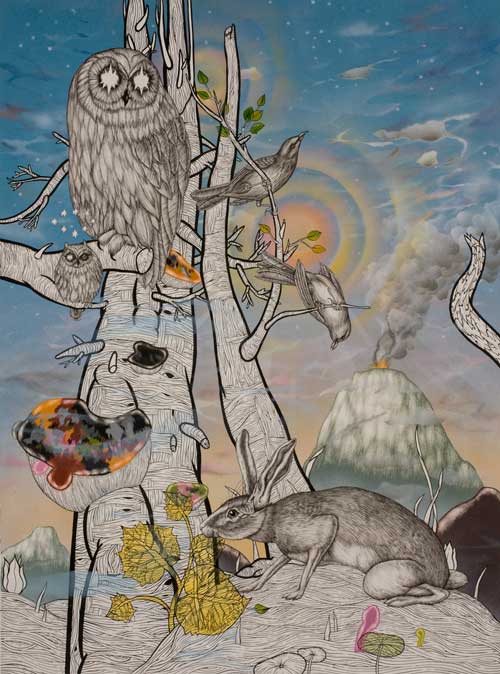
Jon Rappleye, How Evident this Miraculous Vision, 2009, acrylic and spray enamel on paper, 29.5x22 inches
Next door to McKenzie Fine Art is the Jeff Bailey Gallery which I often skip because I so rarely like anything I see there. This time I saw Jon Rappleye's Forgotten Planet (until May 23, 2009) which left me feeling undecided. I can't quite say that the work is really good, but neither did it strike me as bad or even mediocre. It's technically good, and the various styles Jon uses makes for an interesting pictorial experience, but ultimately the paintings are so busy and unfocused, I'm not sure how I feel about them. I suppose if I can, with a straight face, use phrases like "interesting pictorial experience", the work's failed, but I'm not entirely willing to just say that.
Jon's painting is along the lines of work I've been seeing a lot lately, from Christopher Reiger (who's been doing it a long time) to Emily Roz. It seems that going back to nature and animals, and doing so with an eye towards accuracy -- and possibly with borrowings from Victorian scientific illustration -- is in vogue these days. Jon takes that approach and mixes in some graffitti, some Dürer-like drawing, and some surreal backgrounds, with the result being busy paintings populated by birds with glowing eyes, cartoony plants, and erupting volcanoes, among other things. His colors are muted and soft, like watercolors, and overlaid by hard-edged critter cut-outs with animation-style outlines. Some things are lightly colored -- leaves, fire -- while others are left as bare outlines. The effect is one of a very staid phantasmagoria, a kind of suspended chaos, like a swarm of attacking avians safely stuffed and interred in the Museum of Natural History.
Like so many repetitive artists Jon leaves me scratching my head, wondering what his personal iconography is all about, and what drives him to be so obsessive. The few times I've spoken to artists like that I've found they mostly seem mystified by their own mystery -- they don't know where it comes from, they just sort of do it. I suspect that's the case here, too; I imagine Jon saying, "I just think owls are cool."
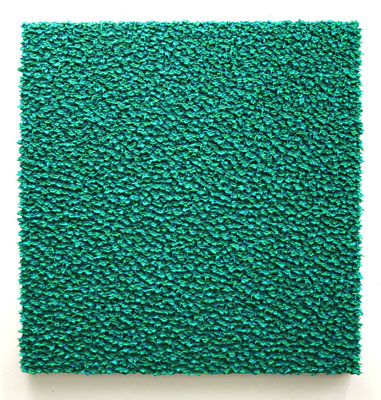
Robert Sagerman, 14,301, 2008, oil on canvas, 48x46 inches
This is most assuredly not what I'd expect from another obsessive artist I saw that day. You can just tell from the title of Robert Sagerman's show at Margaret Thatcher Projects, On and On: Inquiries into Indeterminacy (until June 13, 2009) that this is a guy with an explanation. It's probably not, however, an explanation you want to hear. The first thing I noticed going into the gallery was the explosion of color; the second was the smell of paint. I have no idea what he's mixing into his oils, but it smells like no oil paint I've ever encountered, and in the quantities in this gallery, it's suffocating. And why are his paintings so literally stinky?
Because Robert uses a whole lot of paint. A million oozy tubes of it. Each one of the paintings in this show is built up from thousands of goobery squeezes of paint, piled one on top of the other, like inedible cake frosting. Each painting looks like shelf upon dripping shelf of pigment, matte, sticky, corrugated, yucky. Visually it all combines into a big blob. The texture is mildy interesting but so nearly unmodulated both in color and consistency that you might as well be staring at colorful noise.
And we know each painting is made of thousands of goobery squeezes because Robert counts each squeeze and titles the painting after how many it took. So 14,301 here took that many squeezes. Why 14,301? I don't know. Quick, is it a prime number? I don't know. All I care about is how it looks, and it doesn't really look good.
Finally, and very quickly: On my way out I strolled through George Billis where I saw Stephen Magsig's nice but not especially inspired paintings of New York sidewalk scenes and David Lyle's lovingly rendered, but rendered inert, ironic paintings of surreal suburbia (both until May 23, 2009). And I wandered through Robert Steele Gallery wherein I saw the lovely stained wood sculptures of Joe Segal (closed -- you missed it!). He and J.T. would probably get along.


I really like your writing Chris.
I guess one could say you are a cynic (and I generally like cynicism like I like, oh, say, disease) but then given the subject matter, and the dollops of appreciation you lovingly place here and there all throughout, when mixed with honesty and sincerity and your self-depreciating sense of humor, as well as the timeliness and dare I say: the importance that someone be saying these exact things in this way at this time......
You just come off to me as being a visionary of considerable historical significance.
The perfect thing.
(Then again, I've never read (hardly) any art criticism except for yours, and it may simply be a case of my agreeing with almost everything you say - but I don't think so.)
Anyway.
I think this is an exceptional piece of writing.
A thoroughly enjoyable, insightful and educational read - beautifully illustrated and organized.
A great work of art.
Tim Folzenlogen
I'm glad you notice the dollops of appreciation. Not everyone does. To me, they're the important thing. I've been thinking lately of only mentioning shows I like (or love), simply ignoring anything I didn't like. But I feel that'd be dishonest, for one thing; and also it wouldn't be much of a contribution, and I feel that negative feedback is as important as positive; and lastly, it wouldn't leave me much to write about.
I doubt very much I'm "a visionary of considerable historical significance" but it sure sounds nice.
Oh, I think such things are mostly about showing up at the right time and place. It's a perfect fit kind of thing.
Like Andy Warhole. I don't know that his work was all that "great" in and of itself, so much as it was on time - the perfect fit for that time and place. Everything was moving that way - art as product, artist as celebrity - hype, fashion, surface, image.
What's next (if this planet is to survive) is more of an everybody environment in which everyone can take part.
Make honesty and sincerity (coupled with being open minded - humility) the standard of value, and everyone can play the game. The best ideas will naturally rise to the top.
The internet will definitely play a part, as will expertise (solid product - your blog).
If not the visionary, I think that you are at very least emblematic of what is to come.
But yo.
It's certainly not up to one such as I to decide such things.
If it's to be (as far as any individual becoming a major player) it will simply happen.
In your case, the way you are going - I just think it will, as everything is moving in that direction.
You are a very talented, charming and endearing man.
Create a level field, and I can't imagine anyone not liking you.
Tim
Chris, endearing? Have you actually met Chris?
Tim has indeed met me. But he's also totally bugfuck crazy.